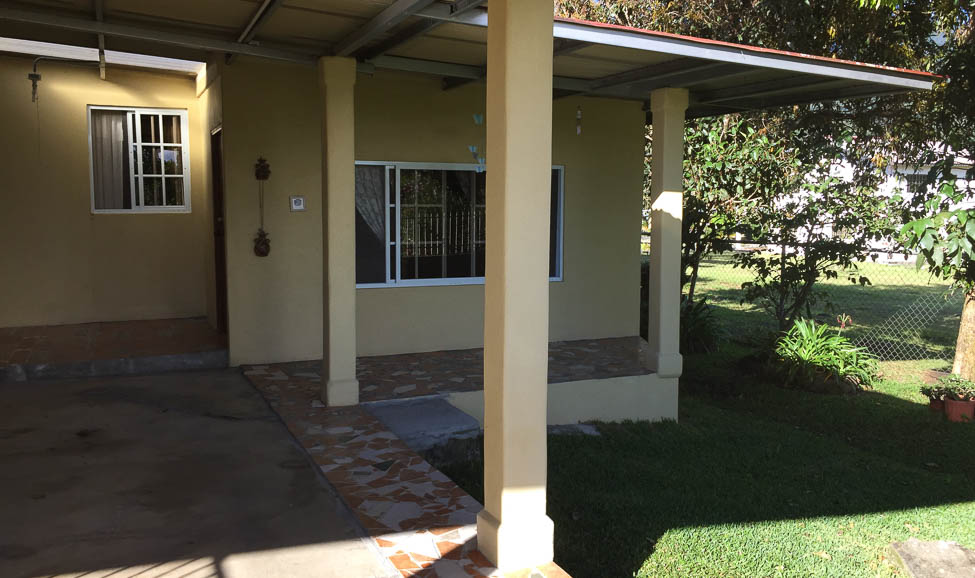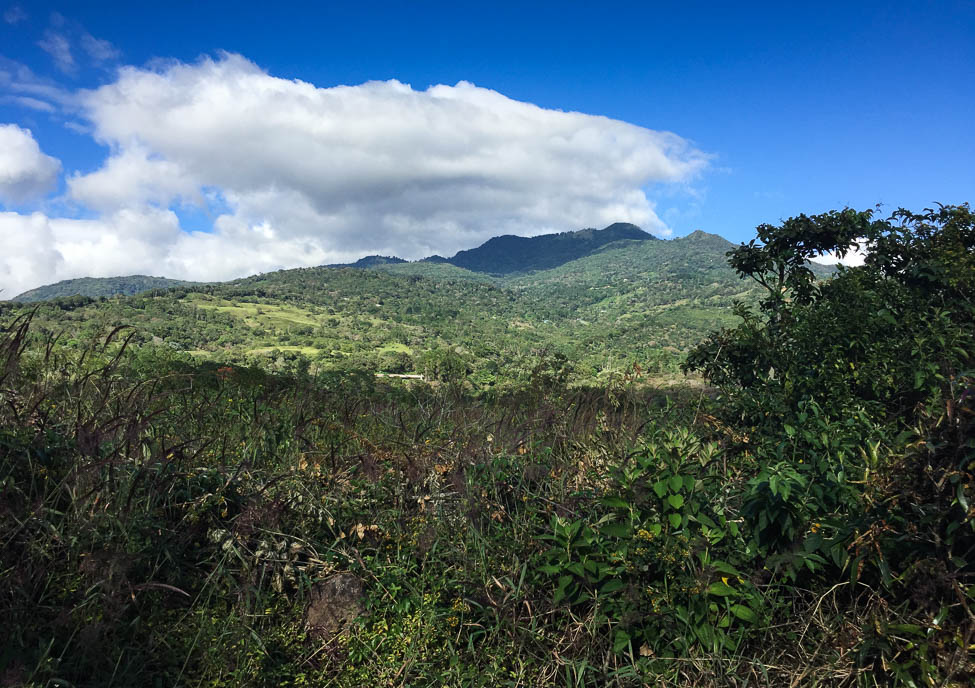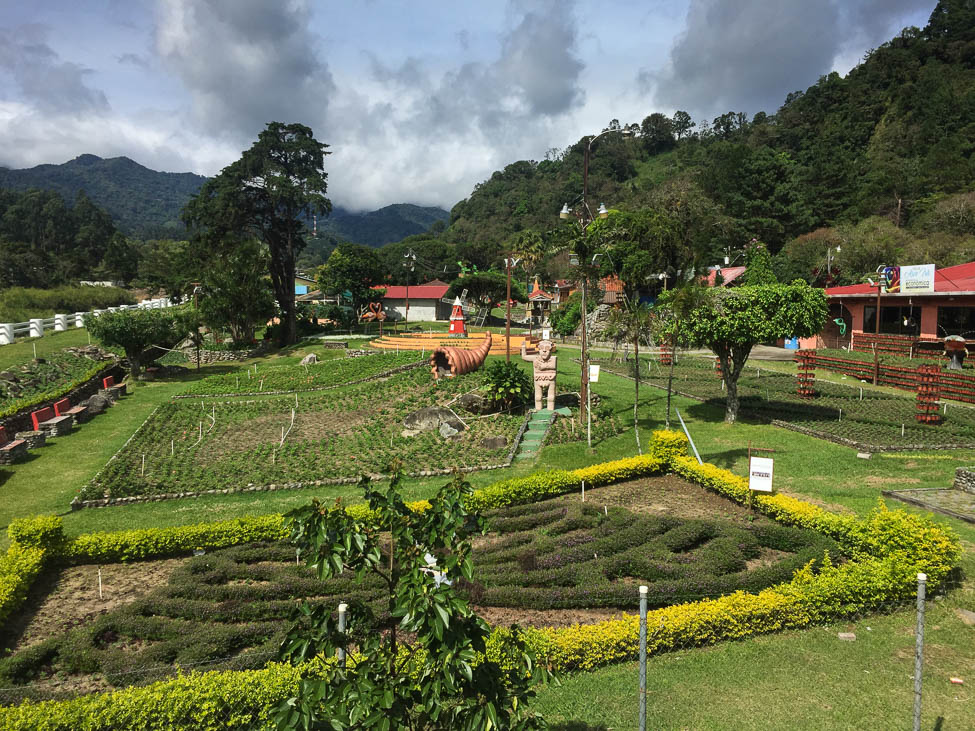Bus To Panama
After spending three of four days water logged in Quepos, it was time to move on to Panama. Researching online, we learned that there was a Tracopa bus which went from San Jose, Costa Rica to David, Panama and that we could board the bus as it passed just outside of central Quepos. When we went to the bus station three days before our travel date, initially we were told that there weren’t two seats together. Since we would be crossing a border, we needed to show our passports. After the ticket agent looked at Ann’s passport, all of a sudden two seats (5 & 6) became available. Later we realized that Ann’s being of a certain age paid off again and qualified us to take the disabled seats. We were told to be at the bus stop across from the hospital at 10 am, we got there at 9:30 am (an $8 taxi ride) and proceeded to wait until 11:30 am, when the bus finally arrived. Apparently, the bus ran into construction leaving San Jose. Luckily the temperature was pleasant and the bus stop provided shade. And it wasn’t raining! We stopped at a rest stop about an hour after boarding and grabbed a quick lunch. The rest of the ride was uneventful until we arrived at the Panama border.
Crossing Into Panama
As we stopped on the Costa Rica side, it was pouring rain (guess Costa Rica wanted one last shot at us). The driver instructed (in very rapid, very loud Spanish) that one of us needed to go across the street and pay the impuesto (departure tax). Ann nodded as if she understood, took the money from Ian and got off of the bus. Ian grabbed our backpacks, expecting to wait for her, only to discover Ann standing outside the bus with a deer in the headlight look in her eyes. So he took the money and passports, went across the street and paid the $8 per person tax. Arriving back, Ann still hadn’t moved and still had that dazed look, so he dragged her to the Salida (exit) line, and we got ourselves stamped out of Costa Rica. (In Ann’s defense, she had never before done an overland border crossing except on an overnight train and in the EU. To Ian’s credit, he had never done an overland border crossing in Latin America, but his experiences in Europe at least gave him a clue as to how such crossings worked.) Then we had to walk to the third building on the Panama side and wait in the Entrada (entry) line. We’d been told that Panama was a stickler for showing proof of onward travel (no problem, we’d already bought our tickets to Colombia) and proof of financial resources (Ian had downloaded a copy of our last bank statement in case they asked). When it was our turn, the noise was so loud that we had a hard time understanding the border agent, but we made it through without having to show onward travel or financial docs; maybe it was edad (age) again. The final step, we needed to have our bags inspected to make sure we weren’t smuggling produce into Panama. This part too was a little confusing as there weren’t any signs, but everything worked out okay and we were soon on our way.
Onward to Boquete
Arriving at the David bus station, it had a Middle East bazaar feel (not that we’ve ever been to one, except for Instanbul), a crazy amount of people, noise, vendors selling all manner of stuff, and at least 50 lanes for buses. We found the Boquete bus, boarded it, looked around and started quietly chuckling. We felt that we’d been transported to India: the inside of the bus was dark red, decked out with curtains, doilies on the seats, a little incense smell, and Indian music playing. The ride to Boquete was about an hour, during which time we got the lowdown on town from an expat and her daughter. By this time, it was dark but we managed to get off at the correct stop and our Airbnb host, Ulises, was waiting to take us grocery shopping before taking us to our apartment. Arriving at our apartment, we found a very large unit and met the owner’s mother-in-law, Aida, a pleasant lady who lived in the main house. The apartment cost us $35 per night, our best deal so far. Our neighborhood was pleasant, quiet, and rural, with friendly neighbors who greeted us as we walked back and forth to the bus stop.


The next day after breakfast, even though it was overcast and threatened rain, we headed into downtown Boquete, eager to explore. A 10 minute walk to the bus stop, followed by flagging down a taxi; apparently all taxis seem to be collectivos, with the drivers stopping en route until they have 5 passengers. At $.70 each for the ride into town – quite the deal.

Boquete is a small farming town, turned adventure tour town for the younger crowd due to its proximity to Volcan Baru, turned retirement haven in the early 2000’s by various retire overseas publications.


Hence a lot of first world retirees descended upon the town, real estate got developed for them, and real estate costs escalated. Since it’s located at a 3600 ft elevation, it’s benefits include a climate that is 70-80’s during the day most of the year and down to the 60’s at night, the only downside being a long and cool rainy season. When it’s sunny, the wind blows strongly; think Santa Ana’s in Southern California.
Boquete Town

Boquete is a pleasant, if bland (in Ian’s eyes), small town. Our concern was that it would feel overrun with expats, but that was not the case. As we wandered around town trying to get a feel for it, we saw mostly Panamanians, including indigenous people, the women wearing traditional dresses.



We even found a microbrewery but we weren’t thrilled with the beer (you didn’t think we wouldn’t try it, did you?). However, we enjoyed the panaderias (bakeries) we found over the next few days. It’s quite amazing that the breads/pastries have been so different in each country that we’ve visited so far. Guatemala’s were similar to Mexico’s, Costa Rica’s were more European, and one type of bread in Panama reminds us of challah. Saturday, the weather cooperated, sunny and windy, so Ann declared it a day to get caught up on chores, particularly laundry (we know we’re bursting the bubble, it’s not all glamour, puppy dogs and roses). Since there was no dryer, Ann spent most of the day doing our full load of laundry, with only one short clothesline and a very limited number of clothespins Ian spent most of the day working on booking our plane reservation out of Colombia, which we would need (to show onward travel) when flying into Colombia next week. We don’t know what’s going on in the middle of January, but all the flights out of Colombia were crazy expensive. He was able to find frequent flyer business class tickets to Mexico for a reasonable amount of miles, so we get to hang out with the 1% for a few hours. We did have time before dark to work in a little walk.
On our last day in Boquete, we went back into town, wandered around again in the rain. We stumbled upon our best Panamanian meal so far, lunch at Go Local, with seating for about 6-8 people. The food was local, fantastic, and very reasonably priced: $4 for lunch including a refresco (fresh local fruit blended with water). We chatted with a local who said the cook is the best in Boquete.
Cost of Living
We were able to eat fairly inexpensively in Boquete by avoiding all imported products in the grocery store (unlike Costa Rica, the local products here are a lot cheaper), and visiting the produce markets which are a real deal, less than a $1 for a pineapple or papaya. In the US, we never liked papaya; it always seemed to have a bland taste, but since Guatemala, the papaya has been fantastic. For meals out, we avoided all the gringo restaurants because we found them expensive, i.e., US prices. Eating at local places serving typical Panamanian food, we were spending a very reasonable $3-4 per person for an entire meal including a fruit juice. For desert, a pastry at the panaderia was $.25-$.50. We ate dinner in our apartment, accompanied by Chilean wine for $5-7 a bottle.
While nothing struck us over the head as being significantly cheaper than in Costa Rica, overall our cost of living had dropped considerably during our stay in Boquete. We were averaging about $75 per day, of which $35 was our accommodation. In Costa Rica, we were averaging about $120 per day (granted we had some unusual costs, e.g, extra airfare, doctor visit, vaccinations, as mentioned in earlier posts), and San Ramon was much less expensive than the beach communities. So we’d say prices were about 25% less than in San Ramon. We did buy bottled water during our stay, as our Airbnb host told us that the plumbing system was being upgraded in Boquete so it was safer to drink purified water. We did brush our teeth with tap water without any issues.
Real estate: While long-term apartment rentals seemed to be slightly higher than in the other places we’ve visited so far, to purchase a lot, home, or condo seemed considerably higher, confirming what we had been told by the expat we met on the bus.
Conclusion
While we enjoyed our four days in Boquete, it is not a potential retirement destination for us. It’s just too small a town. But for someone who is looking for a rural environment with a lower cost of living, it might be a good fit.

A Few Random Observations
Talking with expats in Costa Rica, we kept hearing that ticos are much friendlier to gringos than Panamanians are to gringos. When we talked with a Panamanian expat, she said that Panamanians are more friendly than ticos. Now that we’ve experienced both countries and been treated very pleasantly by every local that we’ve met in both countries, we are a bit confused. Maybe it’s just people’s way of believing that their place is best.
Then at a grocery store in Boquete, Ian might have stumbled upon part of the reason. He was standing behind a gringa lady of a certain age, she didn’t greet the cashier, when she did talk, every word was in English, with some grumbling. It was obvious from the clerk’s body language that she was uncomfortable with the interaction. After the lady left, Ian greeted the clerk in Spanish, asked about her day in Spanish, not a deep conversation just simple stuff, but a pleasant interaction. After leaving the store, he checked his receipt and discovered that he’d been given the Pensionado discount even though he was never asked if he was a resident. It’s interactions like this which confirm first of all the value of friendly, respectful interaction with people, and secondly, that going to Guatemala for language school was the right choice, and yes, Ian has thanked Ann for convincing him to stick it out.
Next up: moving from the highlands of Boquete to the beach at Pedasi (we know, we’ve already determined that Central America beach destinations are too hot for us, but hope springs eternal).
On another note: we now have a Facebook page, @expatornot, on which we try to post short snippets every day for those who want to know exactly where we are and what we’re up to.
Ian & Ann

2 Comments
Durante mi día en David hacía tanto calor que apenas podía obligarme a caminar por la carretera hasta la estación de autobuses. Y yo estaba visitando desde Florida en ese momento, así que estaba acostumbrado al calor. Solo puedo manejar elevaciones sobre 3000 pies.
Durante mi día en David hacía tanto calor que apenas podía obligarme a caminar por la carretera hasta la estación de autobuses. Y yo estaba visitando desde Florida en ese momento, así que estaba acostumbrado al calor. Solo puedo manejar elevaciones sobre 3000 pies.
El camino de Costa Rica a la frontera de Panamá no estaba pavimentado y lleno de baches gigantes.
Nuestra amiga, Leah, le gustaria ir a David porque ella le encanta el calor.
Ian & Ann